This Miso Salmon is marinated in a sweet and savory miso sauce and broiled until the outside is beautifully crisp and the inside is perfectly moist. It’s even better when you serve the fish with Japanese ginger rice. You‘ll make it a staple in no time.
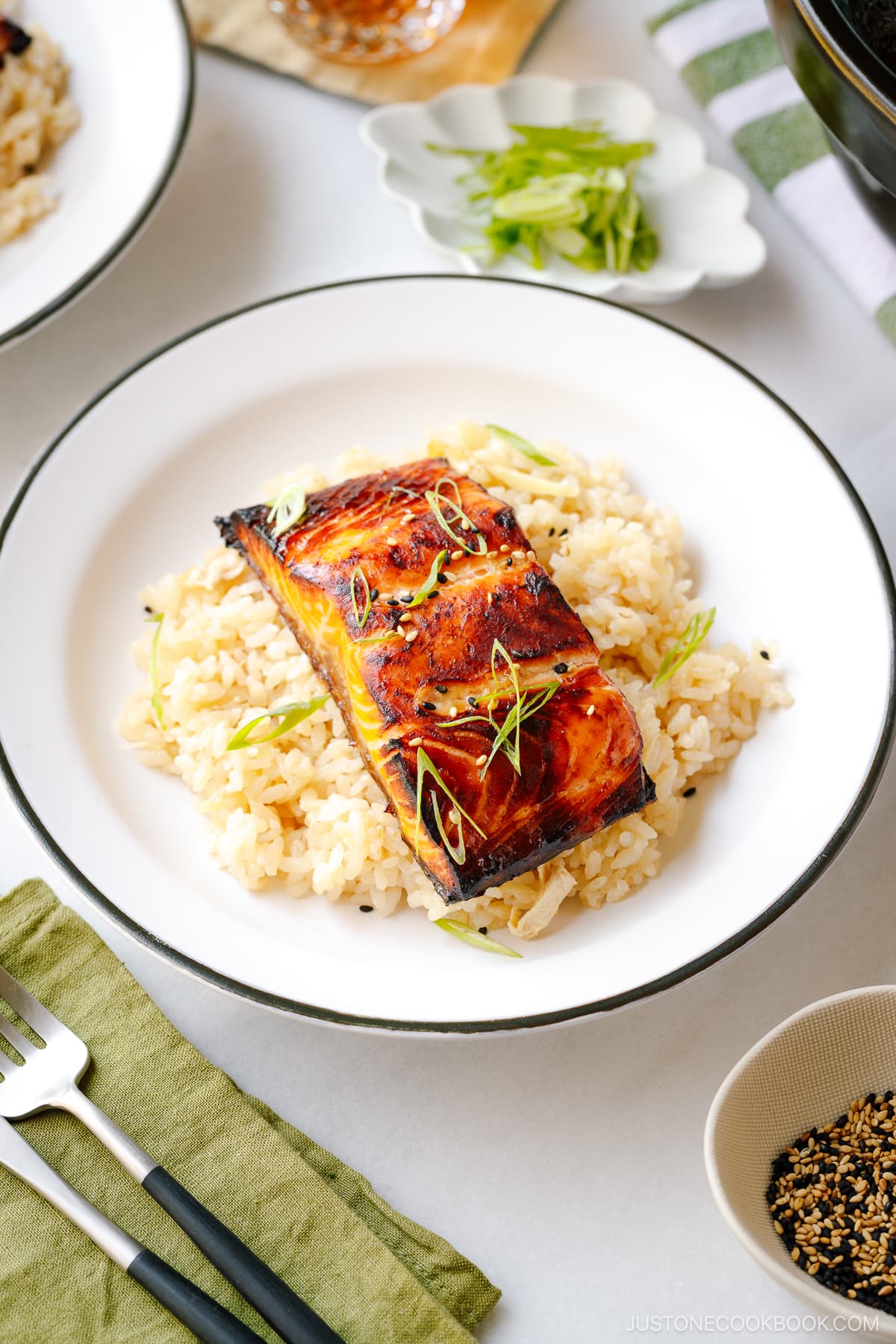
Salmon is truly one of the best choices of fish out there! I love that the fish is readily available, extremely versatile, and makes a healthy protein for any meal. Today, I’m going to share my tried-and-true easy salmon recipe—Miso Salmon (味噌サーモン).
Here, salmon fillets are marinated in a mixture of miso, sake, mirin, soy sauce, and sesame oil, and then broiled until they become succulent and golden brown. You and your family will love how simple and satisfying it is, especially when served with rice and vegetables.
Table of Contents
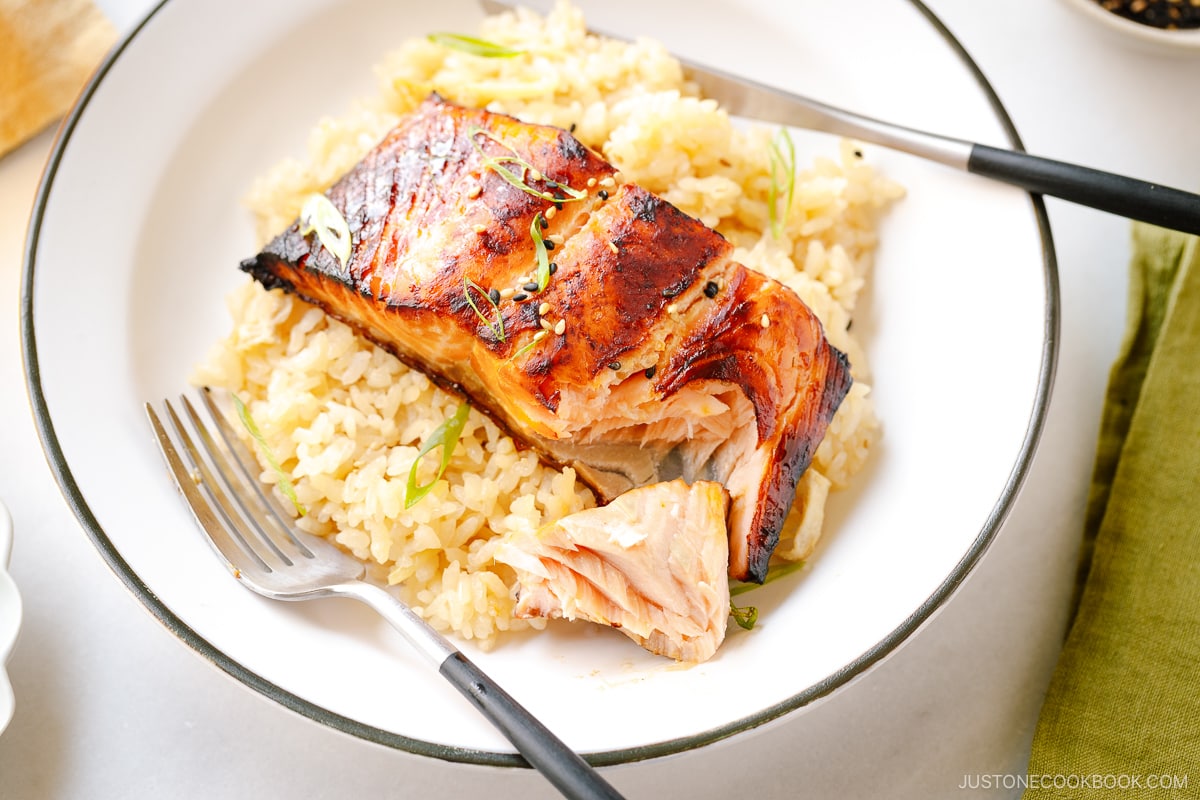
Using Miso in Japanese Recipes
Miso (味噌) is a Japanese condiment primarily made from fermenting soybeans, salt, koji (a fermentation starter), and sometimes rice or barley.
New to miso? Read this post.
From miso soup to salad dressing and miso marinated fish, miso is a common condiment used every day in Japanese kitchens. Its sweet and salty flavor makes it a wonderful marinade, particularly well-suited for fatty fish like cod and salmon.
I have previously shared the Miso Black Cod recipe made popular by Nobu on the blog. In today’s recipe, we’ll learn the best way to apply the miso treatment to salmon and how to achieve flavorful, tender fish with a golden top that everyone will enjoy.
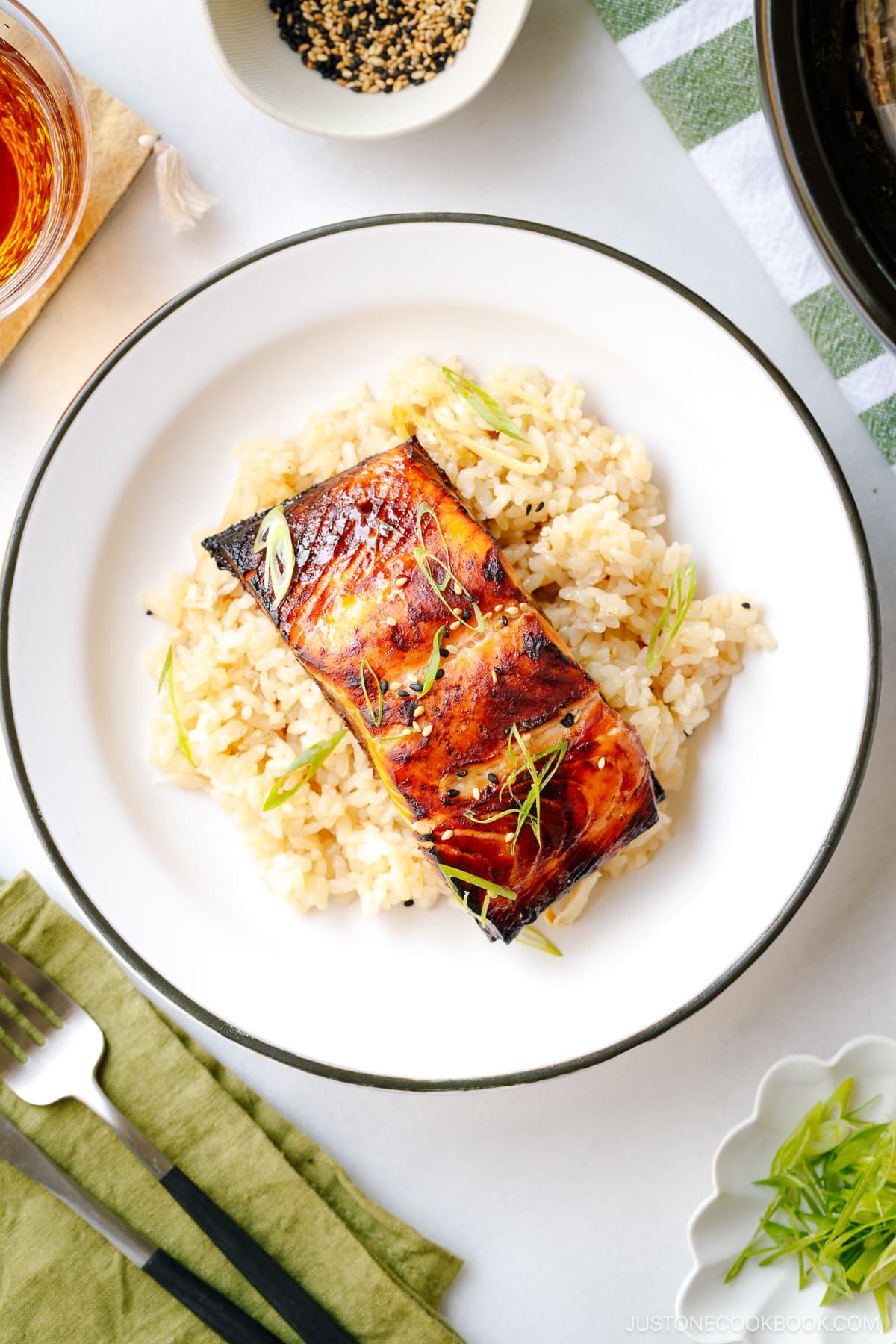
How to Make Miso Salmon
The Ingredients You’ll Need
- Salmon: I recommend using salmon that is less than 1 inch (2.5 cm) thick for broiling. If you don’t have a broiler, wild King/Chinook salmon, which is thick and has a high-fat content, is ideal for baking. You don’t have to worry about the fish drying out quickly. Farmed Atlantic salmon, while very rare to find in the wild, is a more affordable and accessible option.
- Miso: I use white miso (shiro miso) in this recipe for two reasons. First, it is widely available in Japanese and Asian markets, as well as mainstream grocery stores. Second, the flavor profile complements this recipe well. If you have other types of miso, you can certainly use them (I use various miso for this recipe as well). Just remember that each brand and type of miso has a different level of saltiness, so adjust the amount accordingly.
- Soy sauce: I use organic kikkoman soy sauce. Please note that Chinese and Korean soy sauces have slightly different tastes.If you plan to cook more Japanese food, consider getting Japanese soy sauce.
- Sake: I use a $5-8 drinking sake and do not use a cooking sake that contains other ingredients, like salt. Sake is an important ingredient in Japanese cooking (read why it’s important here). If you don’t have it at the moment, use Chinese rice wine or dry sherry.
- Mirin: Just like sake, mirin is another important condiment for Japanese cooking. More about it in this post.
- Roasted sesame oil: We just need a tiny bit for the aroma.
- Garnish: Toasted black and white sesame seeds, and chopped green onion.
The Cooking Steps
- Make the miso marinade and marinate the salmon for 1-2 hours.
- Remove the marinade from the salmon and broil it.
- Serve and enjoy!
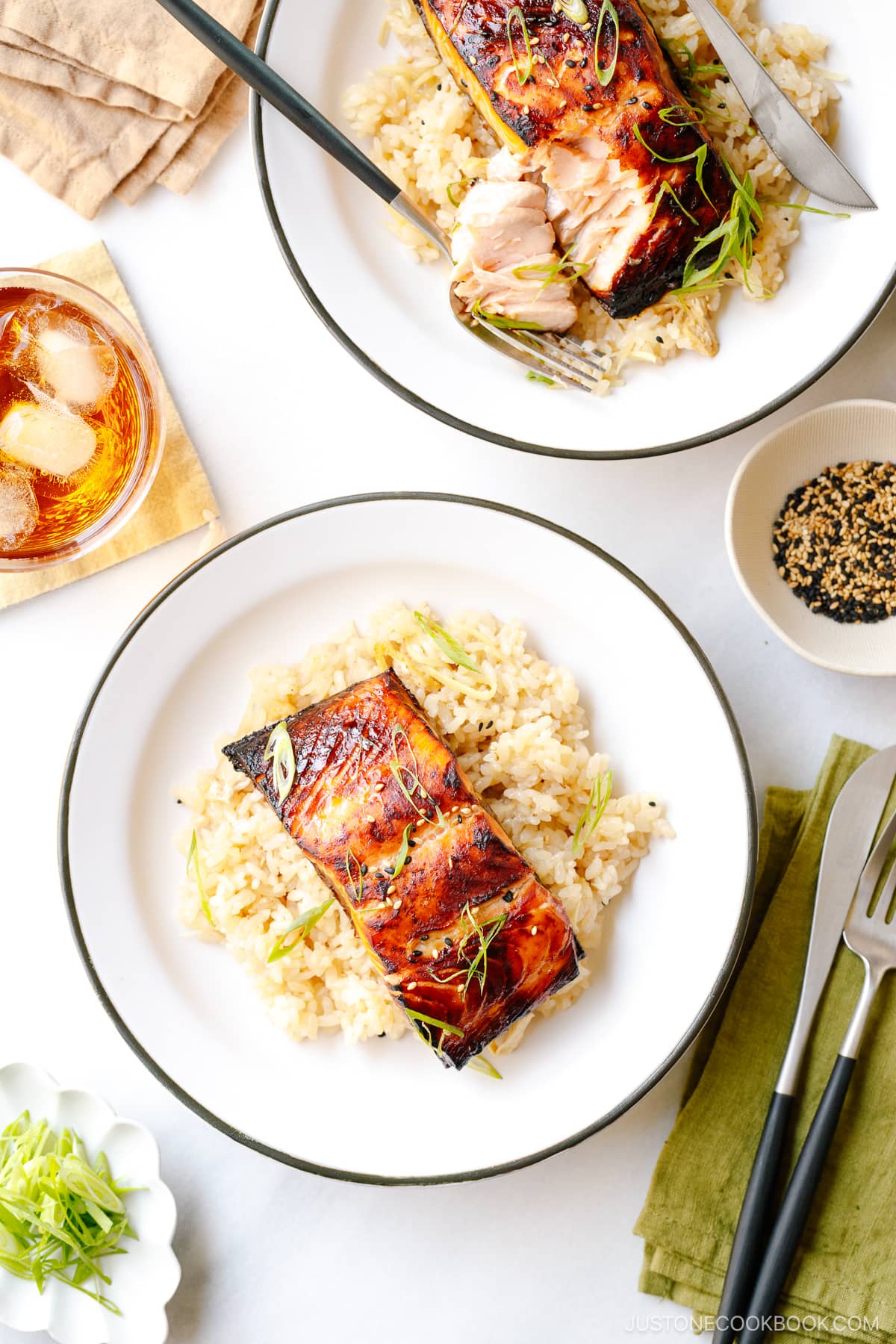
How to Prep the Miso Salmon
It’s a very easy recipe, but make sure to read the following tips to make Miso Salmon successfully on the first try!
- Use skin-on salmon. Don’t remove the skin. It will prevent the flesh from overcooking and drying out. You don’t have to eat it, but keep it on!
- Remove small bones and scales from the skin before marinating. This would make your dinner more enjoyable, especially when you serve it to young children or to your dinner guests.
- Cut the salmon into individual fillets. Smaller fillets marinate and cook quickly!
- Marinade for 1-2 hours. For a salmon fillet less than 1 inch (2.5 cm) thick, you can marinate for up to 2 hours. For thick salmon, you can marinate for up to 3 hours. I don’t recommend marinating overnight because miso is quite salty.
- Remove the miso marinade completely. When cooking miso-marinated food, regardless if it’s fish or meat, you must remove the marinade completely because miso burns very easily. Plenty of flavors have been already absorbed into the salmon. If you still want a nice glaze, cook the remaining marinade with water over the stove and drizzle the sauce over the cooked salmon.
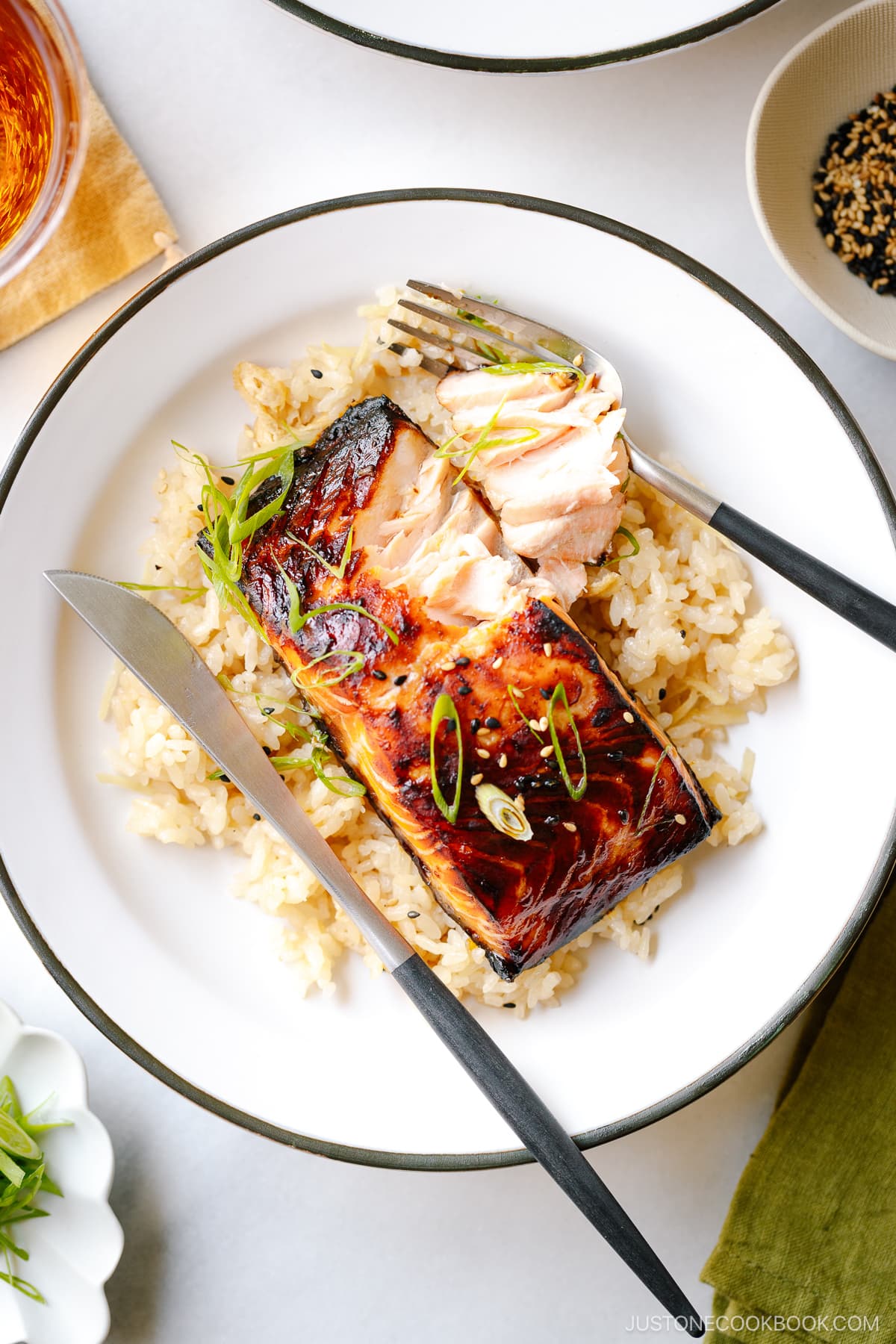
Broiling Tips
If you’ve been baking salmon all this time, I highly recommend trying the broiling method.
When you broil fish, the infrared energy from the heating element cooks the fish. Broiling is a much faster cooking method, resulting in beautifully browned fish that stays juicy and never dries out!
However, it’s important to exercise caution when broiling, as the miso, fresh herbs, and other garnishes are prone to burning. Keep a close eye on the food to prevent burning.
- Use a heavy baking sheet lined with aluminum foil. Avoid using parchment paper, as it can burn under the broiler. I recommend brushing or spraying oil on the foil to prevent the skin from sticking after the salmon is done cooking. You can then use a metal spatula to separate the skin from the foil. Once cooked, the salmon’s flesh can be easily separated from the skin by gently nudging and scooping it up with a spatula.
- Set the oven rack placed in the center position, 9 inches (23 cm) away from the top heating element.
- Set the broiler to high (550ºF/288ºC). My current oven comes with 3 settings (low, medium, and high), but my previous oven did not have a medium setting. Since each oven is different, make sure to control the heat by adjusting the distance of the rack. If you’re new to broiling, you might want to start with a medium setting or keep more distance from the heating element and gradually cook.
- Adjust the cooking by controlling the distance between the broiler and the surface of the food. Unlike baking, you don’t control the temperature in the oven. Broiling is similar to using hotter and cooler zones on your grill.
- Test if the salmon is cooking by flaking the flesh. If it flakes easily, it’s cooked through.
🙋🏻♀️ If your oven doesn’t come with a broiler setting, I included the baking method in the recipe card.
How Long Do You Broil Salmon?
Please remember that the broiling time depends entirely on your broiler’s settings, the distance of the rack from the heating element, and the thickness of the salmon fillets.
When I buy salmon fillets, I always opt for skin-on, center-cut fillets that are less than 1 inch (2.5 cm) thick. And make sure all the fillets are of the same thickness, each weighing roughly 6 ounces (170 g). After marinating the salmon in the refrigerator, it takes 10-13 minutes to broil.
How Do You Know When Salmon is Done?
You can tell when salmon is cooked when the flesh of the salmon goes from translucent to opaque, and the salmon flakes easily with a fork, chopsticks, or by pressing on the fish.
If the fish looks dry, you’ve probably cooked it a bit too long. When salmon is overcooked, you may notice white protein (known as albumin) coming out from the fish. While you can’t undo it, the salmon is still edible, albeit a little dry.
Useful Kitchen Tools
The best method is to use a meat probe thermometer (that comes with your oven) or an instant-read thermometer, especially when the salmon fillets are very thick. With the right tool, you don’t need to guess if the salmon is cooked to the right temperature: It’s perfect every single time.
- A probe thermometer allows you to track the temperature of your chicken, turkey, salmon, etc. in the oven as they cook so you don’t have to repeatedly open the oven door to test.
- An instant-read thermometer is a lot more versatile. You can check the temperature of your deep-frying oil and pan-fried fish or steak.

Frequently Asked Questions
Q: Wait, you said to cook the salmon until an internal temperature of 125-130°F (52-54ºC). I thought we had to cook it to 145°F (63ºC).
The USDA recommends cooking fish to an internal temperature of 145°F (63ºC); however, the remaining heat will continue to cook the salmon, resulting in well-overcooked fish. There are many discussions online on this topic, and many reputable cooking websites do recommend cooking the salmon to 120-130ºF (49-54ºC).
Q: Can I marinate the salmon overnight?
Miso is quite salty, so I don’t recommend marinating the salmon overnight, especially if the fillet is thin. Also, to marinate the salmon evenly, I recommend cutting a one-pound salmon fillet into two to four pieces. One to two hours is my recommendation. If you feel it’s not flavorful enough, please adjust it to your liking.
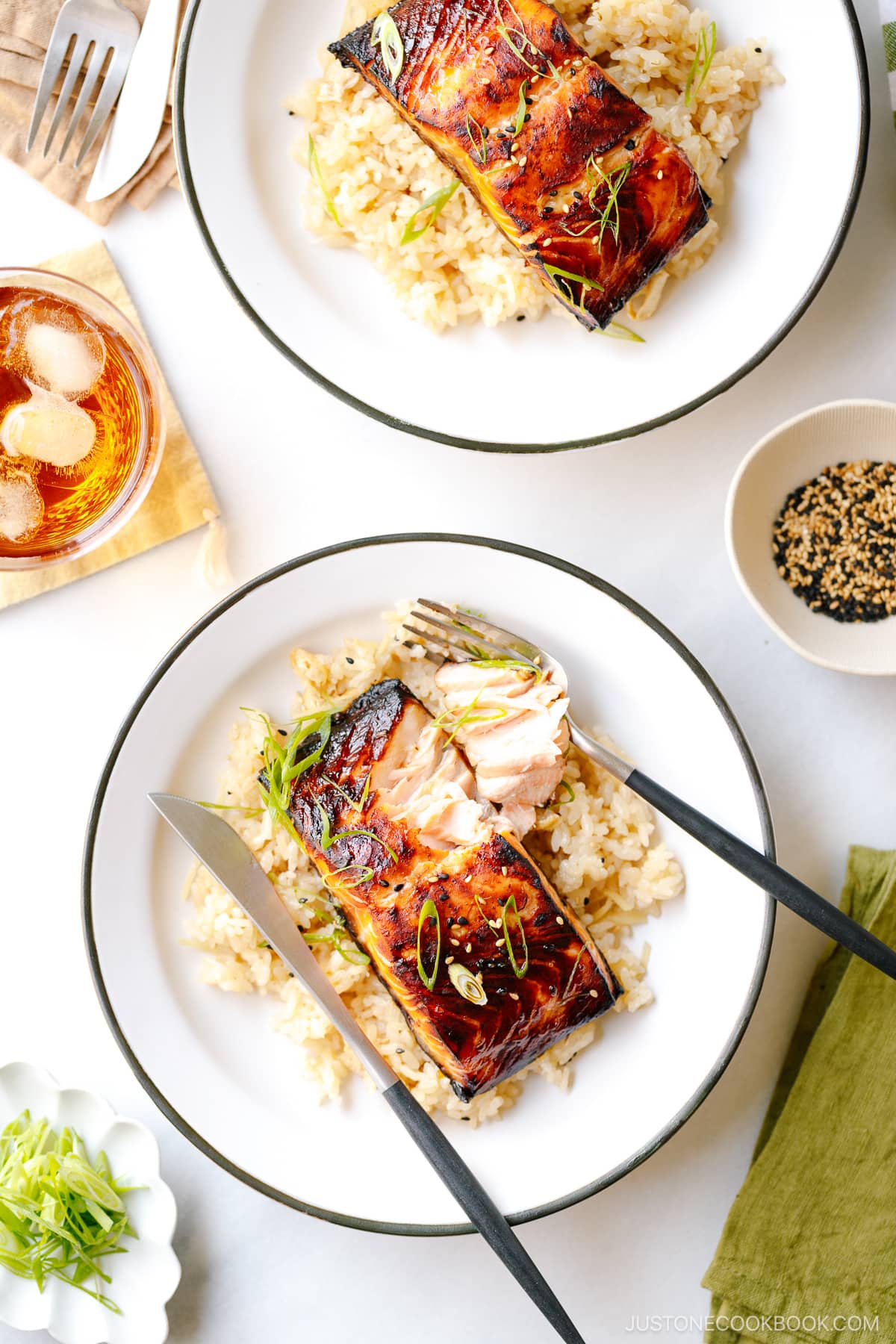
Bake vs. Broil Methods
In case you’re curious, I summarized the differences between broiling and baking fish, and which type of fish is suitable for broiling or baking for your future reference.
Broiling Method
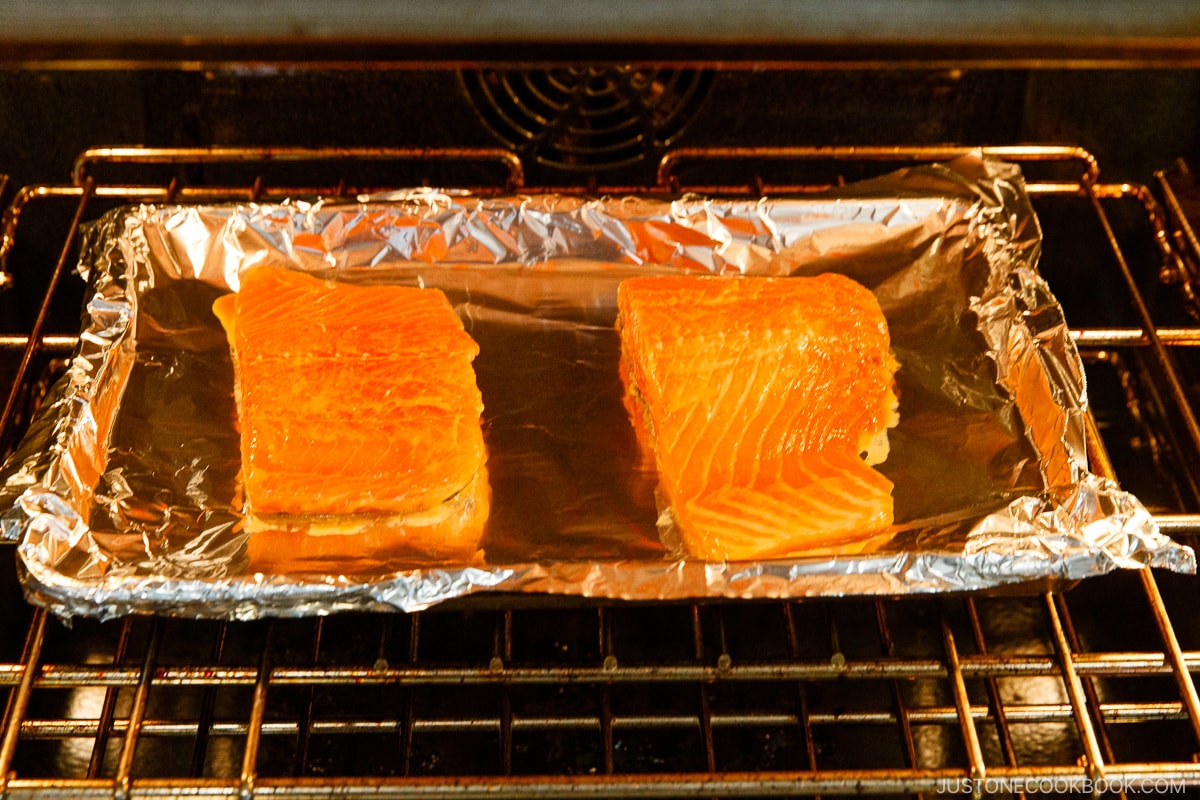
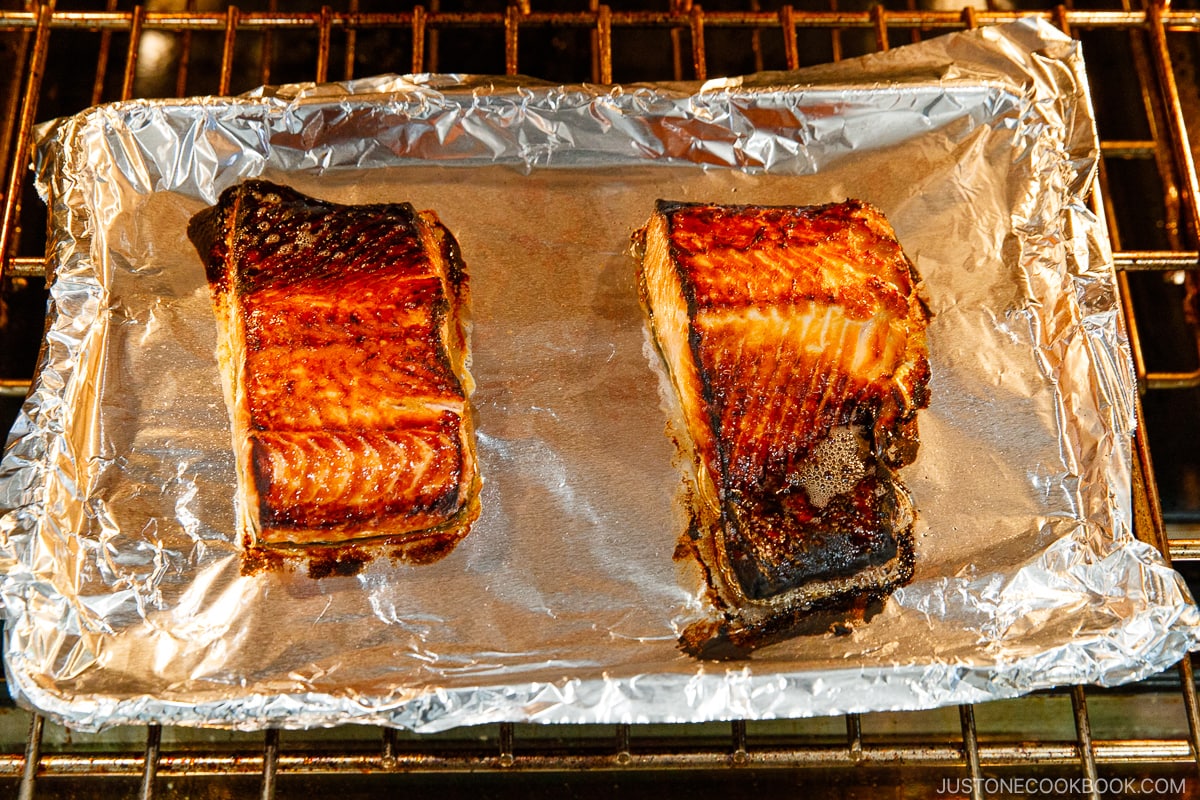
When you broil fish, the infrared energy from the heating element cooks the fish. You don’t control the temperature in the oven; instead, you control the distance between the broiler and the surface of the food.
Fish suitable for broiling:
- Fatty fish—salmon (thin-cut; under 1 inch or 2.5 cm), mackerel, and swordfish
- Moderately lean fish—cod, haddock (should be brushed with oil before broiled)
- Thin fish fillet—Japanese fish cut is often very thin (sold at Japanese supermarkets)
Baking Method
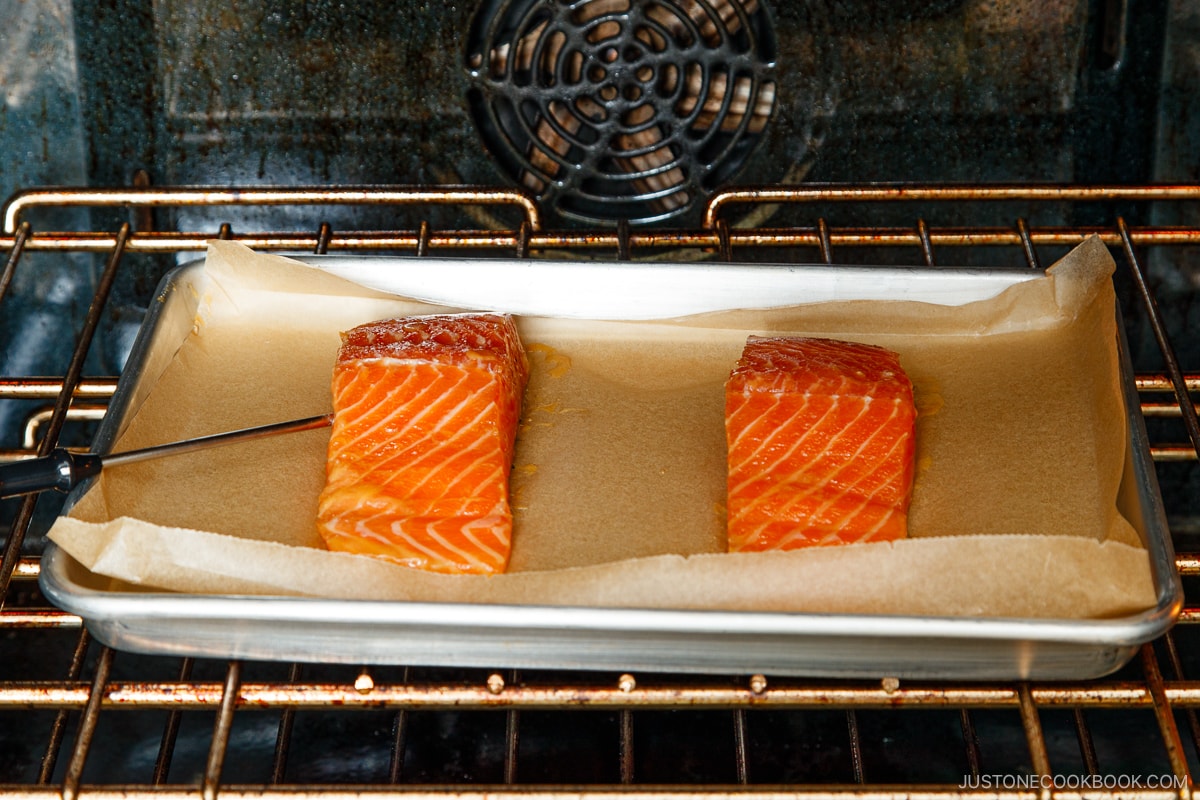
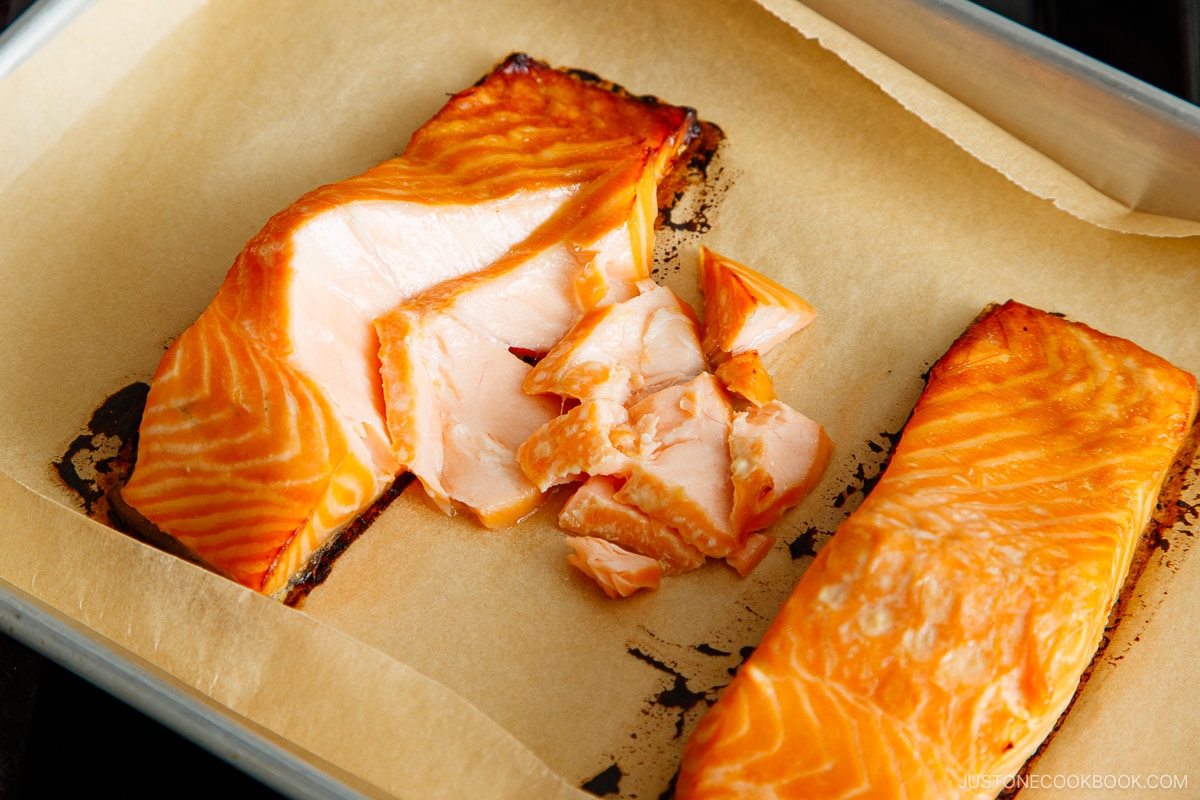
When you bake fish, hot air cooks the fish. The heat is carried through your oven by slow-moving natural currents of hot air, which is why baking takes a relatively long time and makes the fish surface a bit dry (see the image above). But it is more hands-off as you do not need to pay attention constantly.
Fish suitable for baking:
- Fatty fish—salmon (thick and fatty cut), mackerel, and swordfish
- Whole fish
- Thick and large fish fillets
- Lean and fragile fish—sole
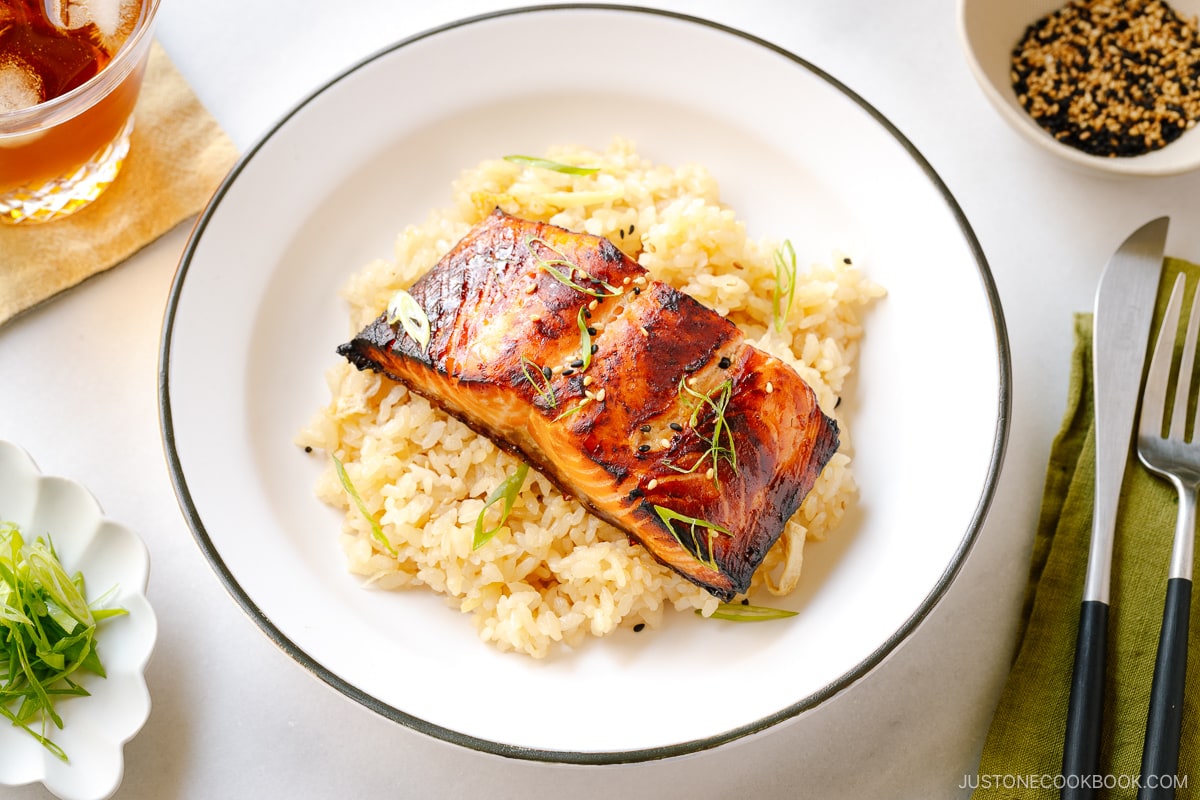
What to Serve with Miso Salmon
For a hearty yet wholesome family dinner, I enjoy serving Miso Salmon with Ginger Rice. The rich flavor of miso-marinated salmon is lovely when matched with the aromatic ginger-infused rice.
Here are other delicious side dishes that you can serve with Miso Salmon.
- Rice: Ginger Rice
- Soup: Kakitamajiru (Japanese Egg Drop Soup)
- Sides: Spicy Japanese Pickled Cucumber and Kinpira Gobo
- Salads: Spinach Gomaae (Japanese Spinach Salad) and Tofu Salad with Sesame Ponzu Dressing
Other Delicious Salmon Recipes
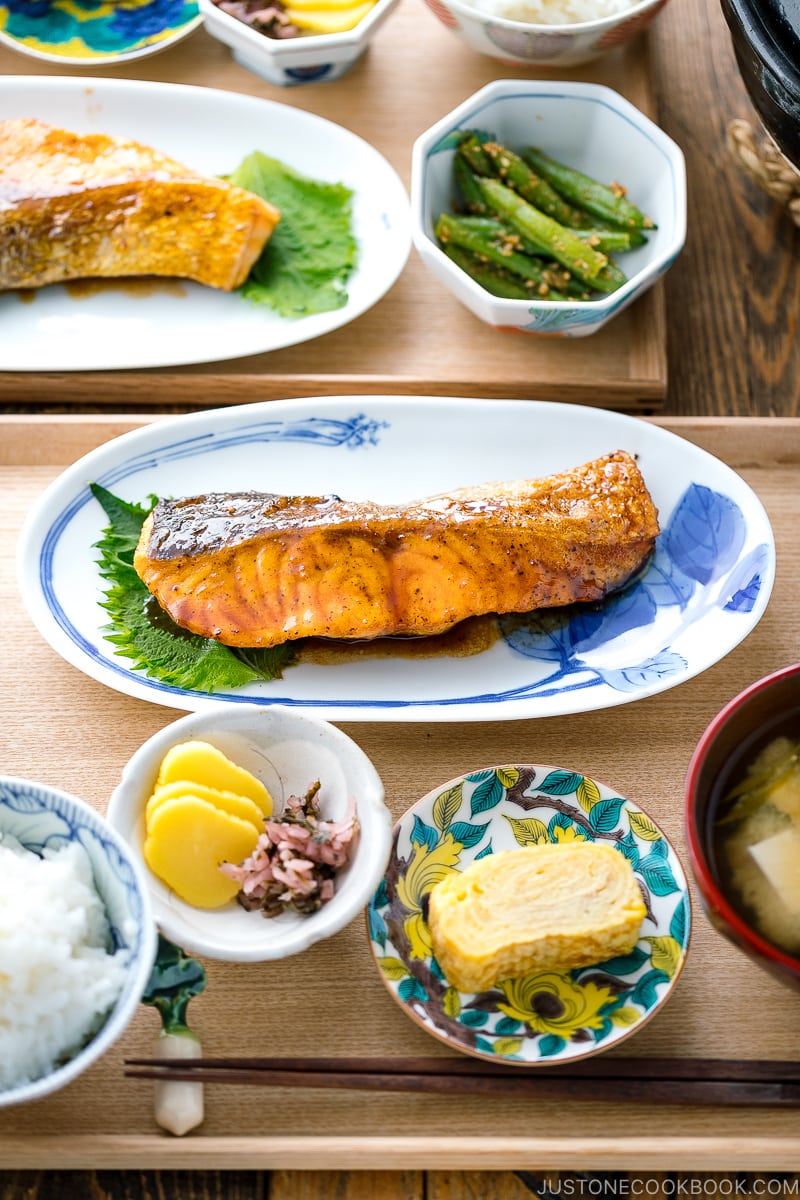
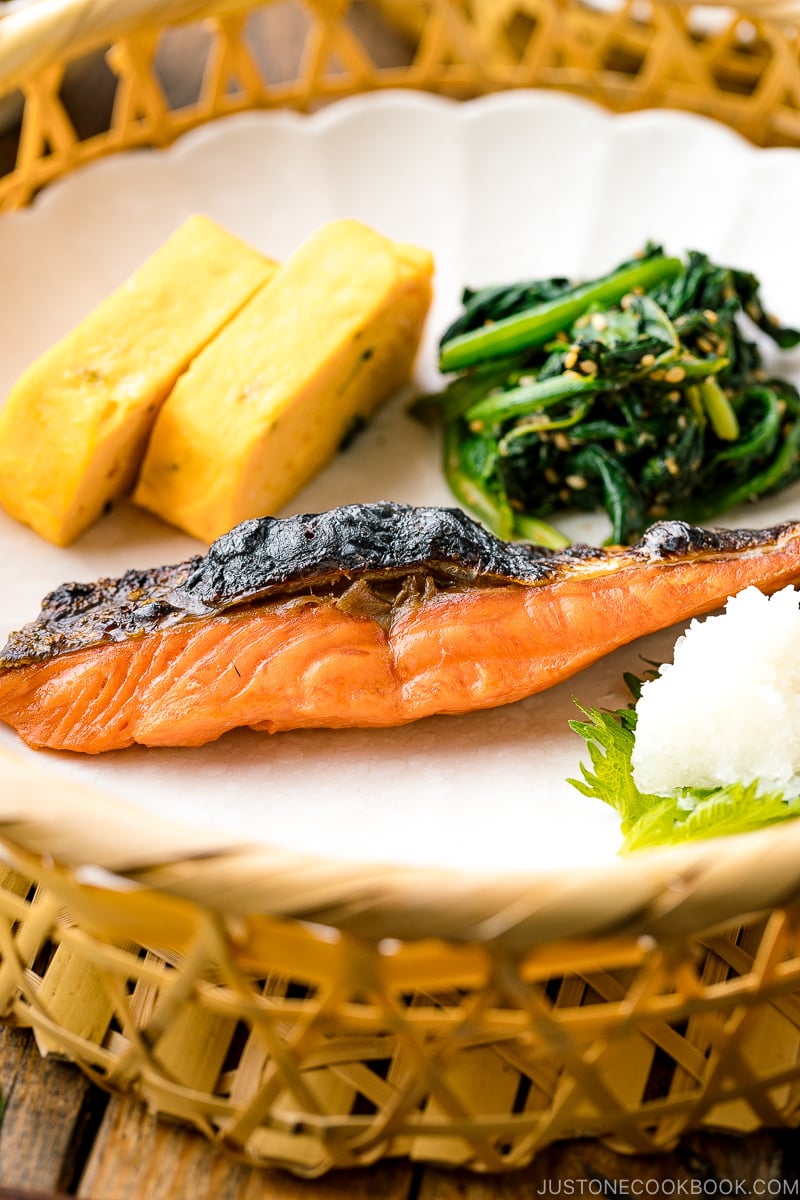
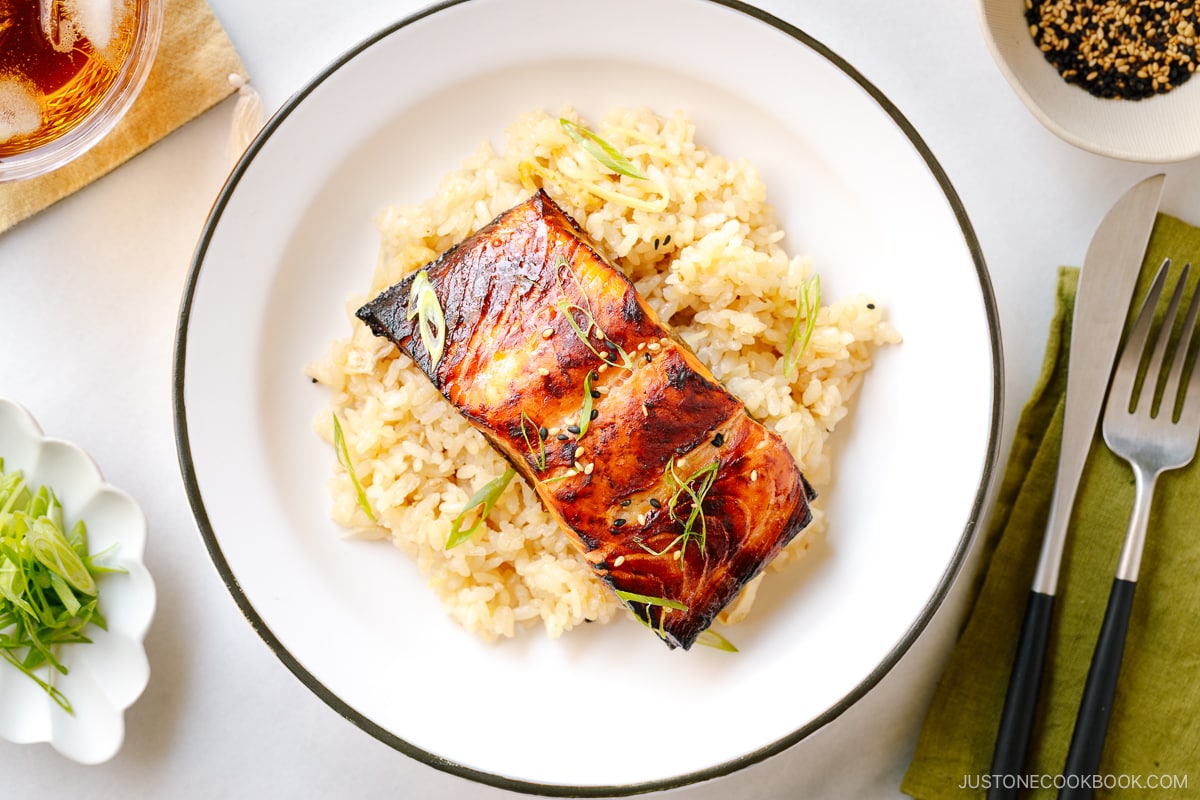
Wish to learn more about Japanese cooking? Sign up for our free newsletter to receive cooking tips & recipe updates! And stay in touch with me on Facebook, Pinterest, YouTube, and Instagram.
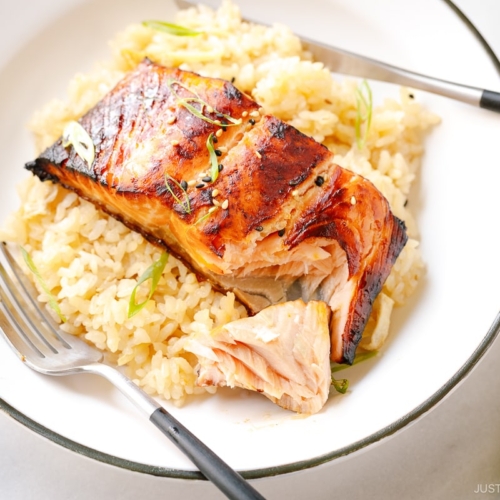
Miso Salmon
Video
Ingredients
- 2 skin-on salmon fillets (¾ lb, 340 g; ideally, less than 1 inch or 2.5 cm thick; 4–6 oz or 113–170 g per fillet)
For the Marinade
- 2 Tbsp miso (use any type of miso; I used Hikari Miso Organic White Miso)
- 1 Tbsp sake
- 1 Tbsp mirin
- 1 Tbsp soy sauce
- ¼ tsp toasted sesame oil
For the Garnish (optional)
- ½ tsp toasted white and black sesame seeds
- 1 green onion/scallion (chopped)
Instructions
- Before You Start: Please note that this recipe requires a marination time of 1–2 hours.
- Gather all the ingredients. Check your 2 skin-on salmon fillets for scales and tiny bones. For bones, run your fingers along the flesh surface and sides to feel for the hard tips of any bones and pull them out with fish boning tweezers. For scales, run your fingers back and forth across the skin to find any scales and scrape them off with the flat edge of a knife.

To Lightly Marinate
- In a large bowl or flat tray, mix the marinade ingredients: 2 Tbsp miso, 1 Tbsp sake, 1 Tbsp mirin, 1 Tbsp soy sauce, and ¼ tsp toasted sesame oil.

- If your salmon is not cut into fillets yet, cut it into individual portions so that they cook faster and evenly. The typical American serving size is 6 oz (170 g). Then, place the salmon in the bowl with the marinade, skin side up.

- Spoon the marinade on top of the salmon, making sure to coat the sides and skin. Cover and keep it in the refrigerator for 1–2 hours for fillets up to 1 inch (2.5 cm) at the thickest part. Marinate for 3 hours for a thicker cut. Tip: This fish is marinated for a short time, unlike Black Cod with Miso. I don’t recommend marinating the salmon overnight, as it will get quite salty.

To Broil (for thin fillets less than 1 inch or 2.5 cm thick)
- Turn on the broiler to High (550ºF/288ºC) with a rack placed in the center position, 9 inches (23 cm) away from the top heating element. Preheat for 5 minutes. Tip: When broiling, you don‘t adjust the oven temperature; instead, you control the distance between the heating element and the surface of the food. It‘s similar to using hotter and cooler zones on your grill. Meanwhile, cut the green onions diagonally into thin slices. Line a baking sheet with aluminum foil (since parchment paper will burn) and spray or brush the oil so the salmon skin won‘t stick.

- Next, take the salmon out of the refrigerator and remove any excess marinade completely; otherwise, the miso may burn during broiling.

- I take the additional step of scraping off the excess marinade with an offset spatula or butter knife (optional). Next, place the salmon pieces skin side down on the prepared baking sheet.

- Broil the salmon until the thickest part of the fillet registers an internal temperature of 125–130°F* (52–54ºC), for roughly 10–13 minutes. You do not need to flip the salmon during broiling. If you prefer it medium rare, you can stop cooking at 120ºF (49ºC). *Please note that the USDA recommends cooking fish to an internal temperature of 145°F (63ºC); however, the residual heat will continue to cook the salmon, resulting in overcooked fish.

To Bake (for thick fillets)
- Preheat the oven to 425°F (218ºC) with a rack placed in the center position. For a convection oven, reduce the cooking temperature by 25ºF (15ºC). Next, take the marinated salmon out of the refrigerator and remove any excess marinade completely from the fish; otherwise, the miso may burn during baking. You can scrape off the marinade with an offset spatula or butter knife if you‘d like.

- Place the salmon pieces skin side down on a baking sheet lined with parchment paper. If you‘re using an oven probe, insert it into the thickest part of the flesh. Tip: If you don‘t have a probe, I highly recommend getting a Thermapen instant-read thermometer.

- Transfer the baking sheet to the oven and attach the probe (if using) to the oven. Bake the salmon until the thickest part of the fillet registers an internal temperature of 125–130°F* (52–54ºC), for roughly 18–20 minutes. You do not need to flip the salmon during baking. If you prefer medium rare, you can stop cooking at 120ºF (49ºC). Tip: My recommended baking time is 5 minutes per ½-inch (1.3-cm) thickness of salmon measured at the thickest part. *Please note that the USDA recommends cooking fish to an internal temperature of 145°F (63ºC); however, the residual heat will continue to cook the salmon, resulting in overcooked fish.

- Take it out from the oven. Test if the salmon is cooking by flaking the flesh. If it flakes easily, it’s cooked through. To char (optional): You can broil the salmon to give it a nice char, if desired. When the salmon is getting close to the desired internal temperature, remove the probe from the salmon and oven. Then, change the oven setting to Broil on High (550ºF/288ºC). Keep the oven rack placed in the center position, 9 inches (23 cm) away from the top heating element. Then, broil the salmon for 3 minutes or until the surface is blistered and browned a bit. Note that the salmon will continue to cook while broiling; therefore, don't wait too long to switch to broil.

To Serve
- Serve the Miso Salmon and top with ½ tsp toasted white and black sesame seeds and 1 green onion/scallion thinly sliced (both toppings are optional). I like to serve this salmon with Ginger Rice. Enjoy!

- Optional: I always discard the marinade (that‘s why I try to use the least amount of marinade), but if you don‘t want to waste it or make too much, you can dilute the marinade with water and cook it for a few minutes. Serve it with the salmon or use it for other dishes.

To Store
- You can store the leftovers in an airtight container and store in the refrigerator for up to 3 days and in the freezer for a month.
Nutrition
Editor’s Note: This post was originally published on September 2, 2014. The post has been updated with revised, clear instructions (still the same recipe) with new step-by-step pictures, final photos, and video on November 17, 2023.
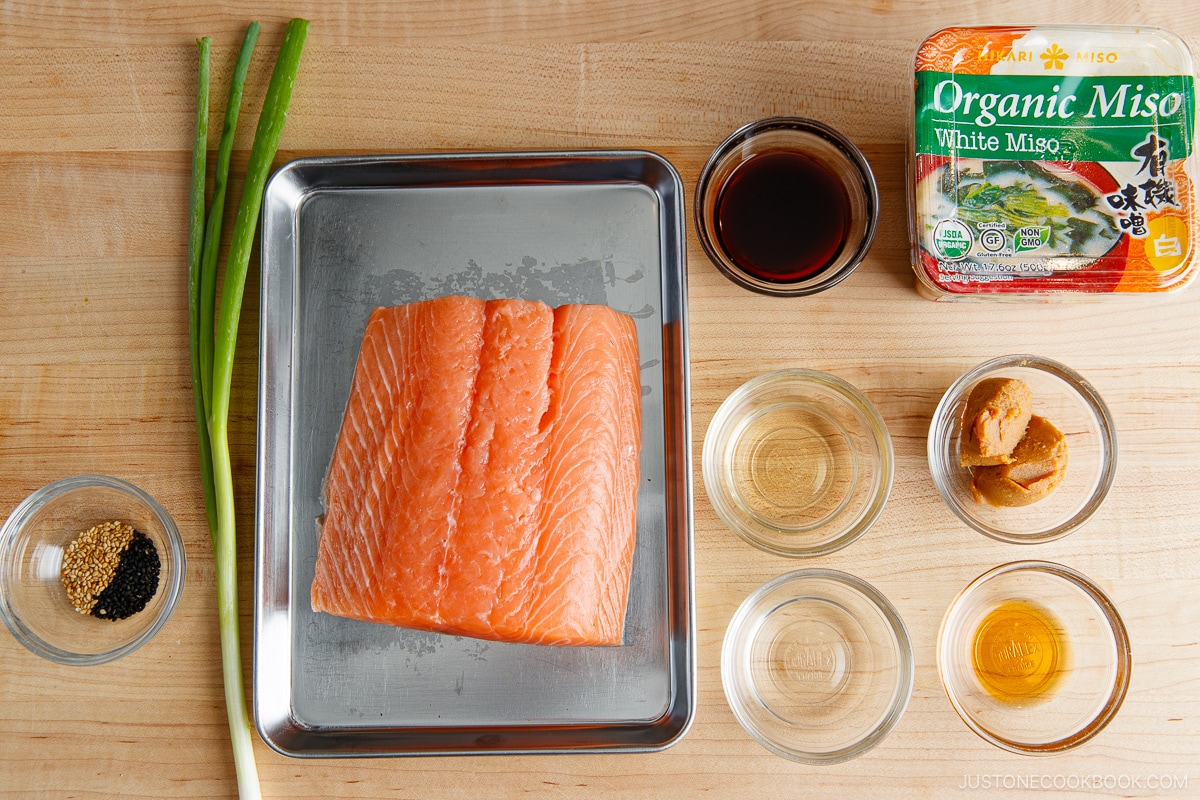
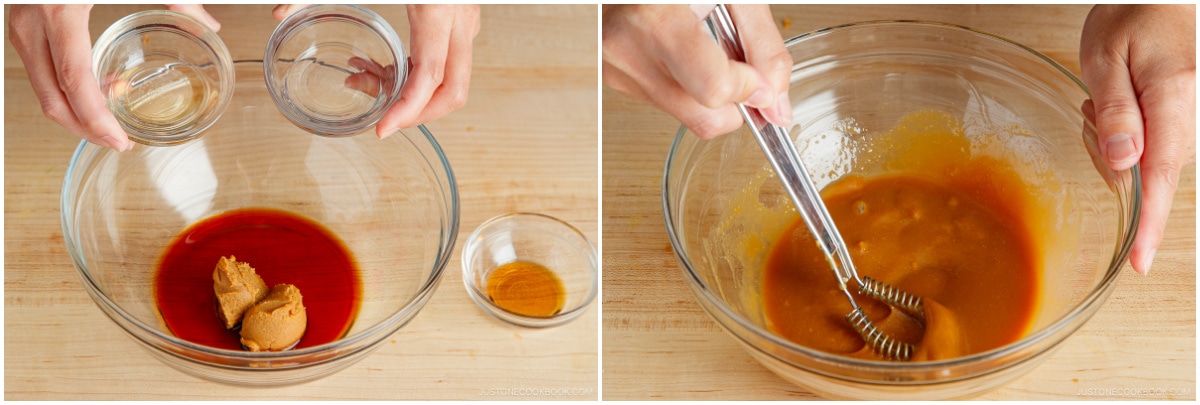
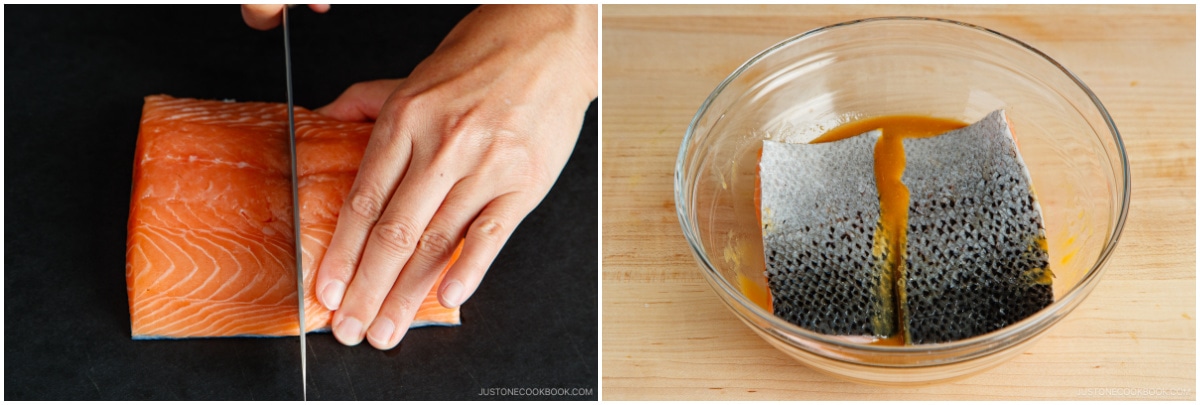
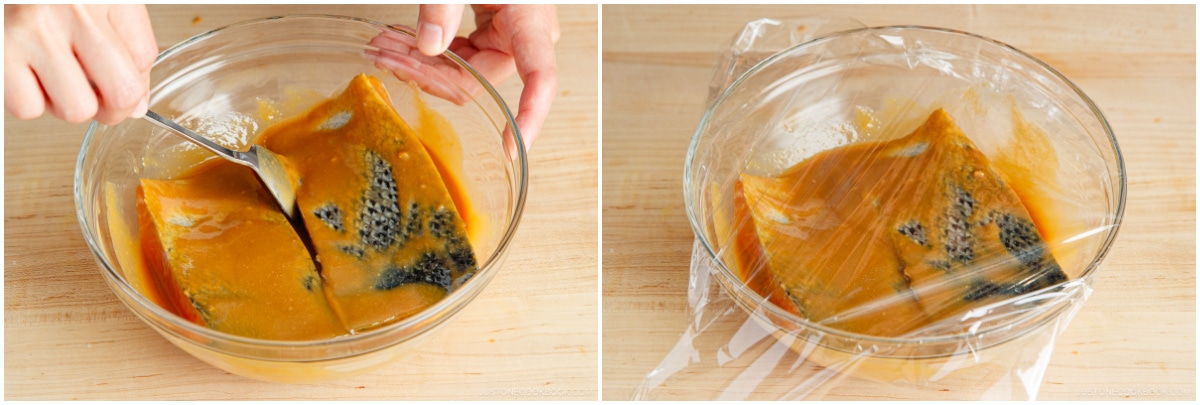
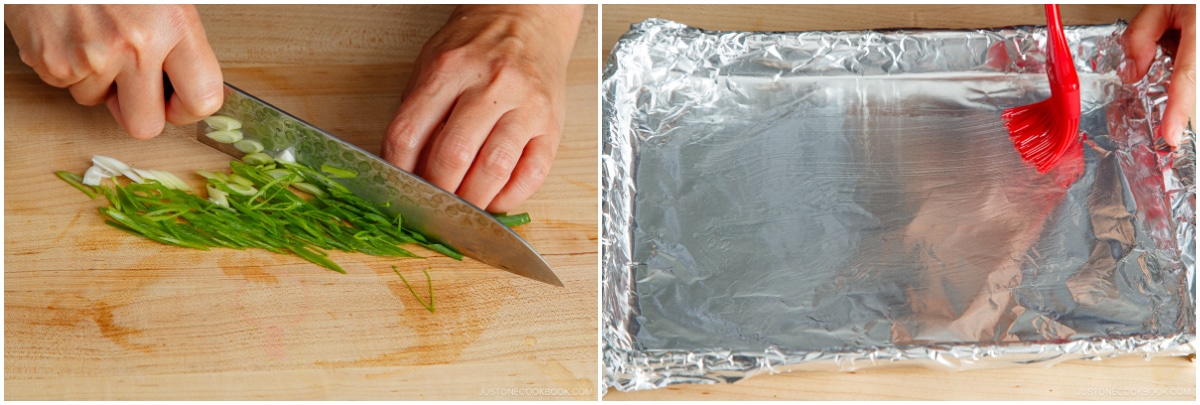
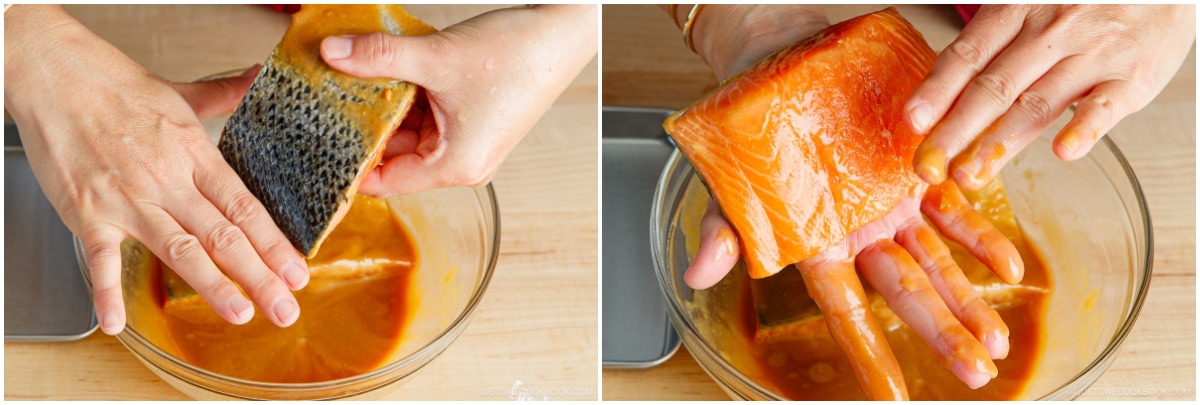
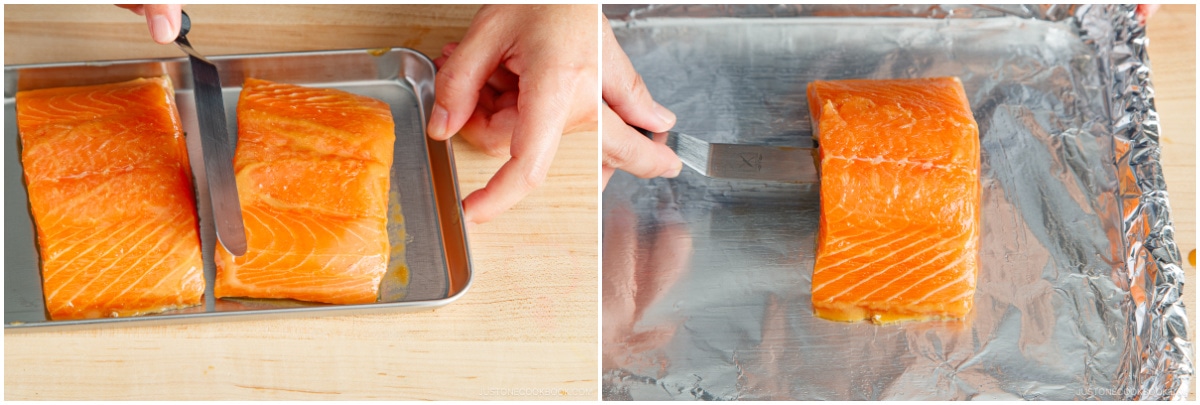
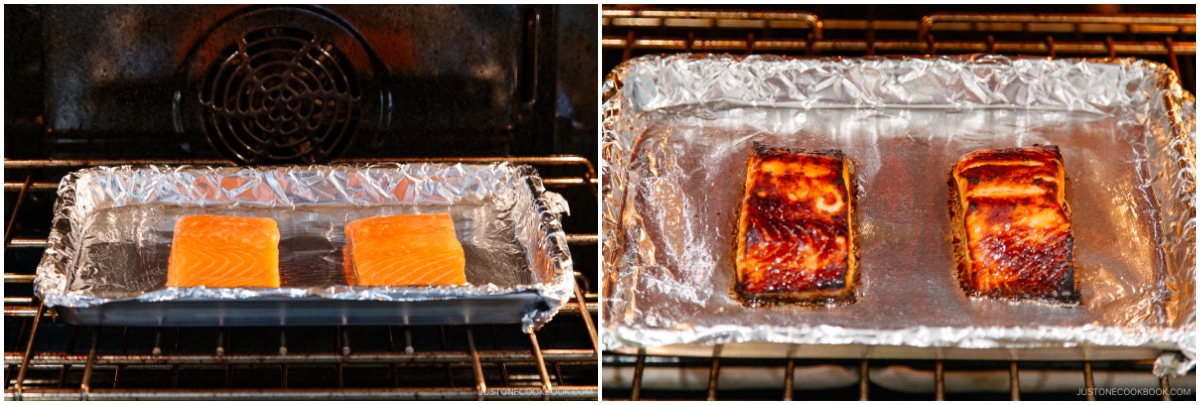
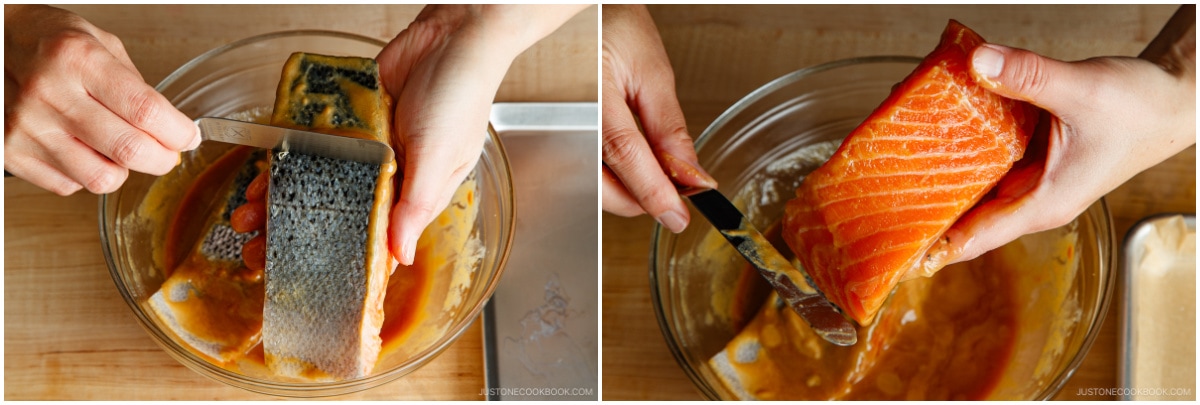
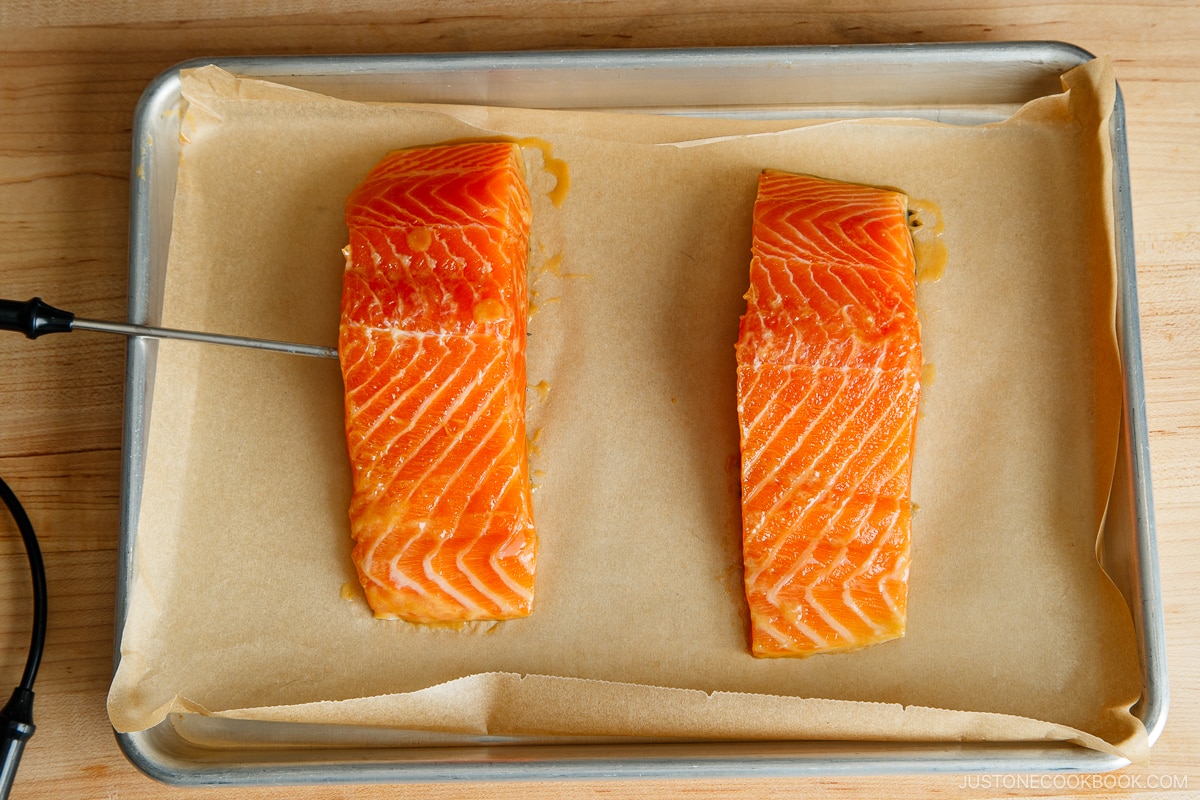
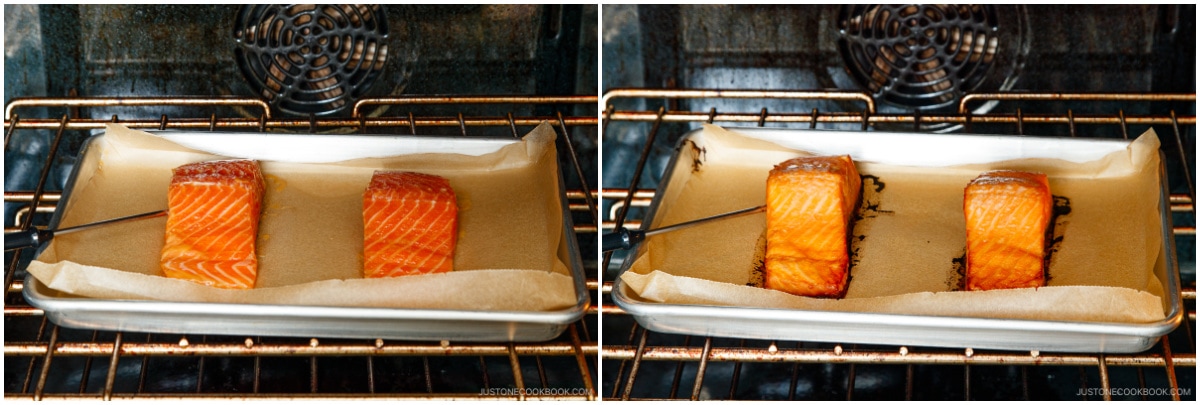
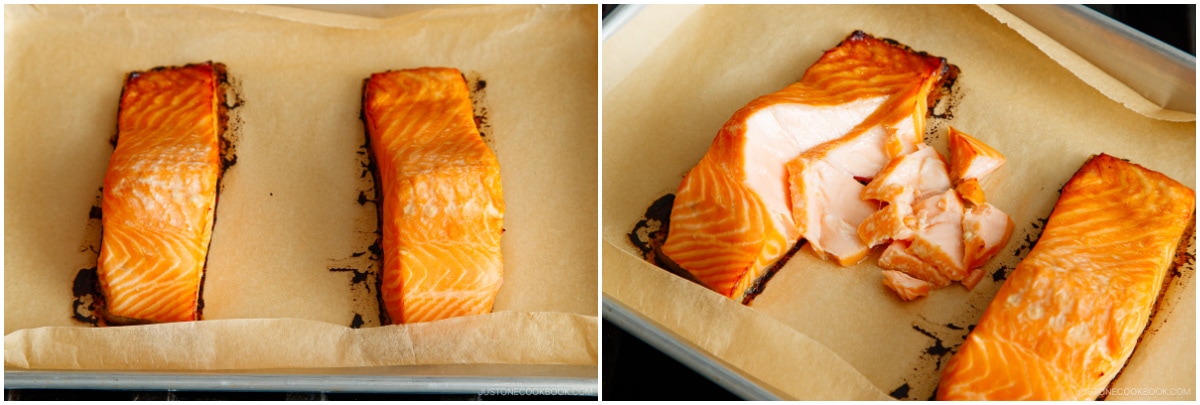
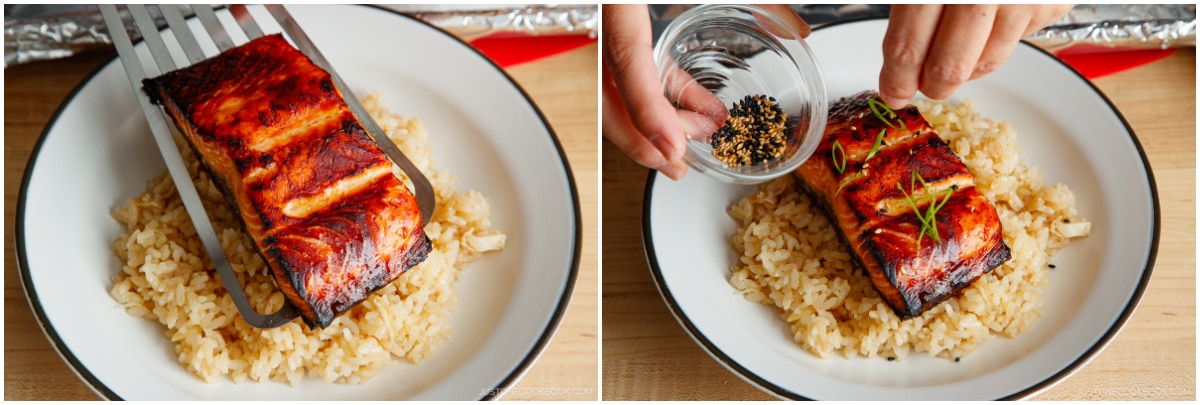
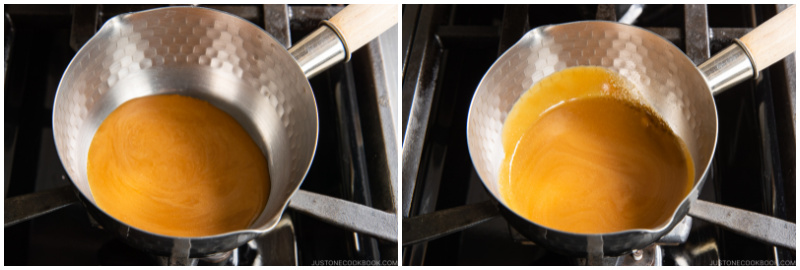










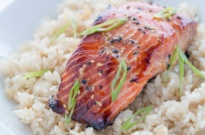
I would love to try this recipe. The problem I have is that as in all the ovens we’ve had, the broiler is in the center and heats intensely directly under it, and not at all once you’re not directly under it. Secondly the distance is only controllable by the rack settings. I think for 4 salmon filets, they could probably fit directly under the broiler but the rack puts them either too close or too far. I’ll have to try to find out. But can this recipe be done in a cast iron pan on the stove instead where temperature is much more controllable?
Hi, John! Thank you for reading Nami’s post and trying out her recipe!
You may try cooking it on a cast-iron pan. If you place parchment paper on the pan, the fish skin will not stick and can be quite crispy.
We hope this works out for you!
Fantastic for salmon! Broiled fillets after 1 hour marinating session! I didn’t have any left over marinade but it was so good especially on the salmon skin I fried afterwards! Thanks so much!
Hi Sharon! We are glad to hear you enjoyed the salmon and salmon skin!
Thank you so much for trying Nami’s recipe and sharing your cooking experience with us.
Happy Cooking!
Yummy. I had to add some water to the marinade though it was way too thick to start with.
I made this for the first time along with your ponzu tofu salad. It was so good! I didn’t have two hours to marinate, so just did what I could while preparing the rest of the food. It was so nice thank you!
Hi, Kay! Thank you very much for trying Nami’s recipe!
We’re glad to hear you loved Miso salmon! Cheers to a wonderful Japanese meal!
I have made the broiled miso salmon twice now. Delicious both times. Thanks so much for the recipe! This will become a staple in our family.
Hello Jayde! Aww. We are so happy to hear you enjoyed Nami’s recipe!
Thank you for trying her recipe and for your kind feedback.
Happy Cooking!
I’ve made miso cod or seabass a few times and really learned not to skimp on the marinating time. Curious why it is so much shorter for salmon? Does salmon just absorb the flavors that much faster?
Hello, Simon! Thank you for using Nami’s recipe.
The salmon is more flavorful, and we believe this marinating time is ideal for the taste.
But if you like a more miso taste, you can lengthen the marinating time as needed. We hope this helps!😊
Really enjoyed this recipe. Wouldn’t change anything on recipe the next time around.
Hi William! We are so happy to hear you enjoyed Nami’s recipe!
Thank you so much for trying her recipe and for your kind feedback.💞
My family and I love this recipe, they can’t get enough! Super easy to make for busy weeknight dinners and so flavorful! Another tasty Nami recipe for sure!
Hi Marilou! Aww. We are so happy to hear you and your family enjoyed Nami’s recipe!
Thank you so much for trying her recipe and for your kind feedback.
is there a reason this recipe does not use sugar as the cod version does?
Hi Michael! Thank you for trying Nami’s recipe!
This is a bit different version and didn’t include sugar. If you like a sweeter flavor, you may add it.🤗
We hope this helps!
I followed the recipe exactly and even measured the 9″ from the heating element (gas boiled). Took it out at 130… Perfection. Thank you!
Hello, Ryan! Wow! It’s perfect!
Thank you so much for believing in Nami’s recipe and giving it a try!👏🏻
This was EXCELLENT!!! This is going into my regular rotation!
Hi Jess! Thank you! We are glad to hear you enjoyed Nami’s recipe.
Happy Cooking!
My husband and I love salmon, and this was a nice change to the usual salmon I make. It was so easy to make and was delicious!
Hi Tiffany! Thank you for trying Nami’s recipe!
We are glad to hear you and your husband enjoyed the Miso flavor. Happy Cooking!
Hi Nami, your recipe is a success! The miso cuts through the rich fattiness of salmon and the ginger adds tanginess to the whole dish.
Hi Yvonne! Thank you so much for trying Nami’s recipe and for your kind words!
Nami and all of us at JOC are so happy to hear you enjoyed the dish. Happy Cooking!
Great recipe! Worked out quite well for me. Off the subject but I wish websites were in 16X9 orientation.
Hi James! We are glad to hear you enjoyed Nami’s Miso salmon recipe!
Thank you so much for your kind feedback and suggestions.
Happy Cooking!